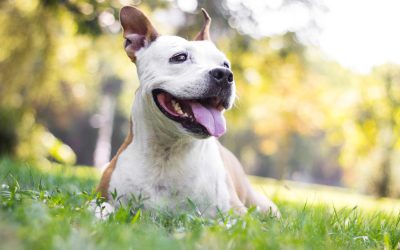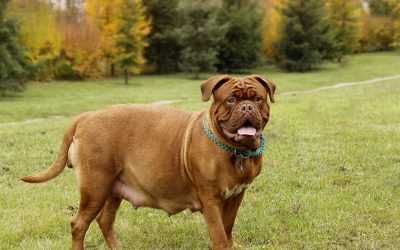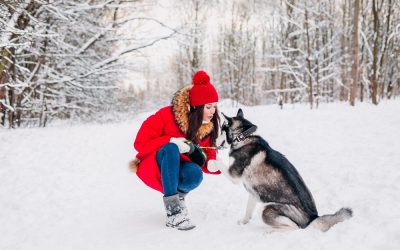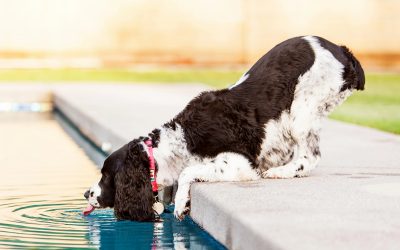Ever look over at your snoozing pooch and laugh because it’s flat on its back, all four legs straight up in the air and head hanging over the side of its dog bed? While this hilarious sleeping position may not look comfortable to you, it might feel blissful to your furry friend.
It could also be full of hidden meanings. Dogs sleep in all sorts of funny positions, but these poses can actually reveal a great deal about your dog’s personality, mood and even its health. Let’s dive into a dog’s sleeping habits to learn what your pup is trying to tell you.
The Most Common Dog Sleeping Positions and What They Mean
Dogs have a knack for getting comfortable when it’s time to snooze, often leading to some unusual positions. Whether curled up in a tight ball, stretched out like a beached whale with its back legs splayed behind it, or upside down with its belly exposed, a dog’s different sleeping positions can mean something unique. We’ll explore the meaning behind six of the most common sleeping positions to learn what they might reveal about your pup’s mood and well-being.
1. The Side Sleeper: Ultimate Chill
Possibly the most common sleeping position for dogs, the side sleeper position means your dog feels safe and secure in its environment. In this position, your dog lays on its side with its legs extended and is likely in a deep sleep. Your dog probably has some of its best dreams when sleeping on its side because it’s so relaxed and comfortable in familiar surroundings. Because this sleeping position exposes part of its belly — considered a vulnerable spot — side sleeping generally indicates that your dog trusts you to keep it safe while it sleeps. Overall, this sleeping position suggests your dog is happy and well-adjusted.
2. The Curl (The Donut): Cozy & Conserved
When a dog curls up tightly in a ball with its limbs tucked close to its body and nose tucked to its tail, it may be trying to tell you that it’s cold and seeking warmth. The donut position conserves body heat and is commonly chosen by dogs sleeping outdoors or in colder climates. However, this position also protects vital organs, meaning your dog may be feeling vulnerable, cautious, and protecting itself while it sleeps. The curl is literally a dog’s version of the fetal position, making it feel more secure as it naps. A dog getting used to a new home may opt for this popular sleeping position until it feels safer in the unfamiliar environment.
3. The Belly Up (Crazy Legs): Totally Trusting
The belly-up position is one of the funniest to behold but actually puts your dog in a vulnerable position because its belly is exposed. When your furry friend sleeps on its back with its legs in the air, it’s generally a sign of complete trust and total relaxation. However, your pup may just be feeling hot, and because this unusual position exposes its belly, it’s an easy way to cool down its body temperature quickly. Belly-up sleepers are generally extremely comfortable in their surroundings and can fall asleep just about anywhere.
4. The Superman: Ready for Action!
If you have an energetic, playful dog, the Superman pose may be its go-to sleeping position. In the Superman position, your dog lays on its stomach with its front and back legs stretched out like it’s flying. While your pooch may look like it’s sleeping, it’s probably a light snooze, and your dog is ready to spring into action at a moment’s notice. In fact, puppies sleep in this position because it makes it easy for them to jump up and start a play session. Alternatively, if your dog routinely does this on a cold surface, it may just feel hot and want to cool its belly.
5. The Back-to-Back (or Snuggler): Bonds of Love
When dogs lie pressed up against humans, other dogs or household pets while sleeping, it indicates a deep bond and desire for affection. Your cuddle bug loves to feel close to you or fellow pets, so it’s most comfortable falling asleep curled up with you or another animal instead of alone in its comfy bed. Dogs who favor this position might enjoy the comfort of companionship, have strong pack instincts or want to show love for humans. Conversely, your furry friend may only favor snuggling when it’s cold and seeking warmth.

6. The Burrower: Seeking Security
The burrower bug position suggests your dog has anxious tendencies or simply enjoys cozy environments. Burrowers snuggle with pillows or blankets or underneath furniture instead of with people or animals. This dog position when sleeping can indicate many things, including that it’s seeking warmth, comfort or security. To help your furry friend get the best sleep, ensure it has a secure space with soft, warm bedding to burrow into and feel more comfortable.
Why Understanding Your Dog’s Sleeping Position Matters
Understanding your dog’s sleeping positions goes beyond simple curiosity. It can offer valuable insights into the comfort, health and emotional well-being of your pet. Dogs have limited ways to communicate feelings but often do use body language. Sleeping positions is one form of body language dogs tend to use subconsciously.
Because each position tells a story, it’s crucial you pay attention if your pet has a sudden change in consistent sleeping positions. Recognizing changes in how dogs sleep could be the first indication that a dog feels stressed or there’s been an environmental change that’s upsetting it. Like a dog that suddenly begins drinking lots of water, a pet that significantly changes sleeping positions or patterns can indicate a health issue, such as joint pain in senior dogs or digestive discomfort at any age.
However, changes in dogs’ positions while sleeping may not mean anything. Most dogs have more than one favorite position for sleeping. Your pup may simply be in the mood for a different sleeping position temporarily, such as when the weather is warmer or colder. Many fur babies have more than one place in the home where they like to sleep and may adopt different dog sleeping positions based on what’s more comfortable in each location.
Tools like the Halo Collar have features that can help you monitor your dog’s sleeping habits or other activities. This information can help you stay in tune with your pet’s needs and potentially catch behavioral changes earlier.
Safe & Sound With Halo: Sleep Easy Knowing Your Dog Is Secure
When you understand your dog’s sleeping positions, you get a glimpse into its comfort and emotional state, helping you ensure it has a happy and healthy life. The Halo Collar offers a blend of GPS tracking and virtual fence technology that provides peace of mind, letting you know your furry friend is secure even when you’re not by its side.
With the Halo Collar, you can set safe boundaries, monitor your dog’s location and relax knowing it’s protected both day and night. The all-new, redesigned Halo Collar 4 is even more powerful but lighter to provide a comfortable fit all day. Its improved battery life and dual-frequency GPS mean advanced accuracy and longevity.
Ready to give your furry friend an extra layer of protection? Visit the Halo Collar website to learn how to keep your dog safe and sound year-round.










